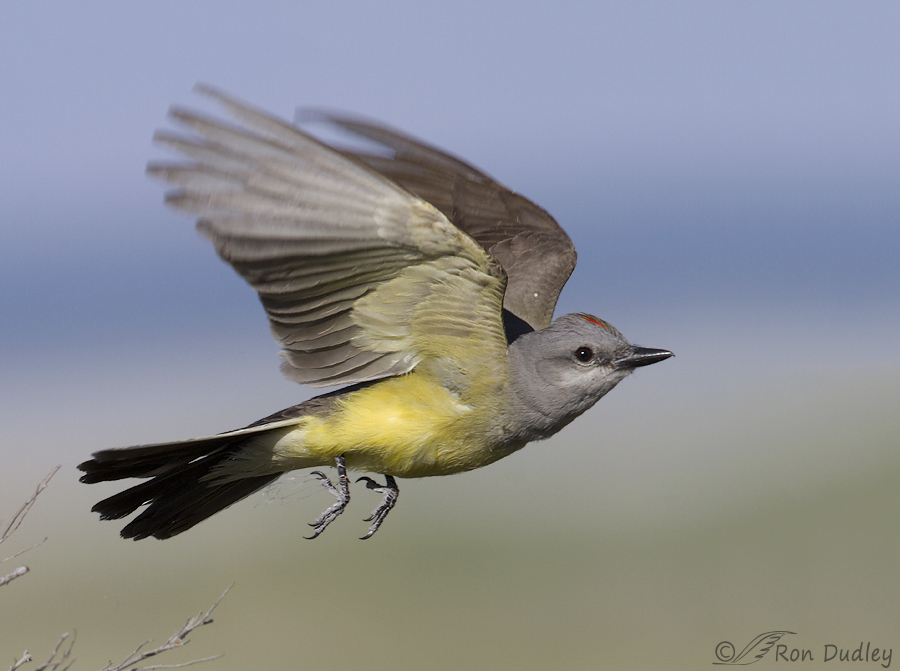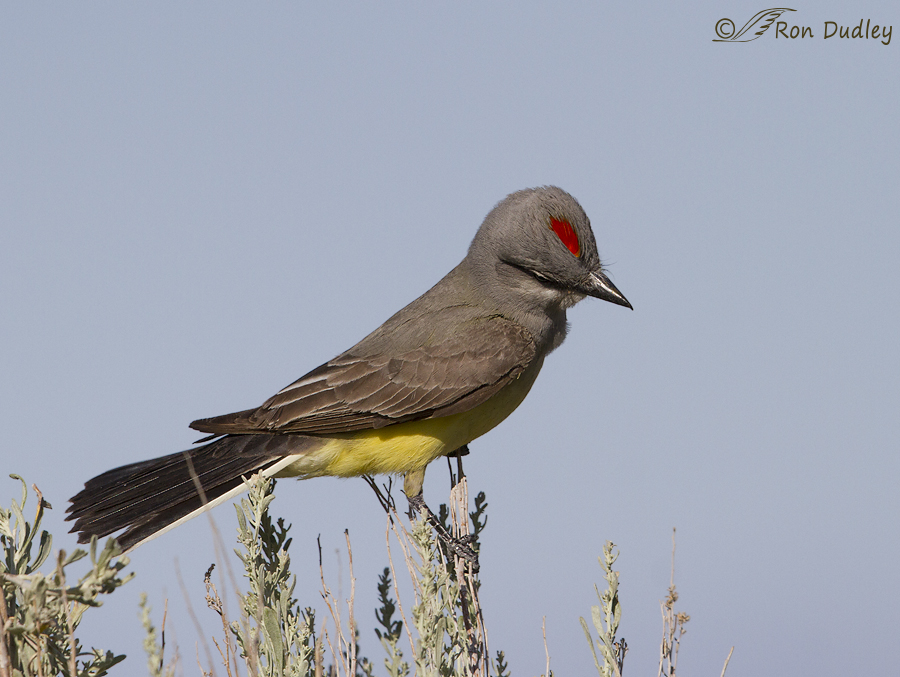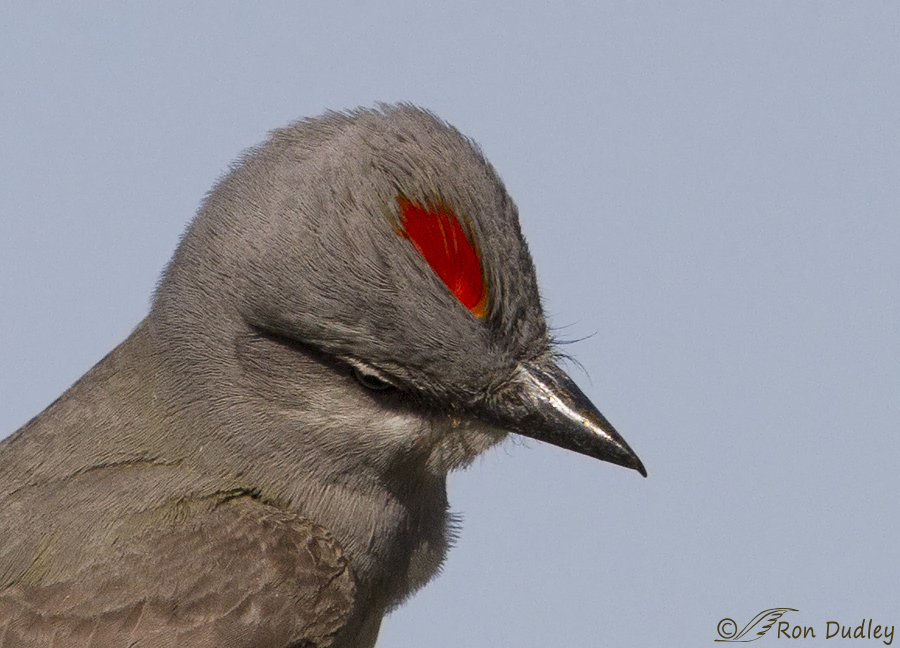Many are surprised to learn that the Western Kingbird (both sexes) has a reddish-orange crown patch that bisects the top center of its head. The patch is usually kept concealed but occasionally they will quickly flash the patch at unpredictable moments, especially when other birds invade their territory. I’ve featured the crown patch on my blog previously but earlier this summer I had my best look at it so I thought I’d revisit the subject this morning.

1/2500, f/8, ISO 500, Canon 7D, Canon EF500mm f/4L IS II USM, canvas added for composition, not baited, set up or called in
Usually when the patch is flashed it happens so quickly that most folks don’t notice it but photographs can capture the moment in time. This bird was taking off from the vicinity of its nest on Antelope Island and I didn’t even know that the patch was visible until I processed the image. When the head is at an angle good for photography (like this, with the eye clearly visible) the view of the patch is usually at an angle that doesn’t show it particularly well.
- A note to photographers: Sharp-eyed observers may notice that the tips of the wing primaries appear cut off and straight-edged instead of rounded as one might expect. This effect can be caused when the fast-moving wing tips are photographed at shutter speeds insufficient to freeze the motion. The movement of the feather tips while the shutter is open creates a straight line that is sometimes reminiscent of sloppy or heavy-handed processing (particularly when canvas is added or cloning is done). It’s an effect that doesn’t appeal to me, even when it’s not due to sloppy processing (and another one of the reasons that I usually use relatively fast shutter speeds for birds).

1/4000, f/7.1, ISO 500, Canon 7D, Canon EF500mm f/4L IS II USM, not baited, set up or called in
But if the bird tips its head down at just the right moment it’s possible that the patch may be more clearly seen. This kingbird did just that as it looked down at its mate on the nest. Usually when I’ve seen this behavior it’s a reaction to another bird (often another kingbird) flying in close but this time my concentration was through my viewfinder and I didn’t see another bird.

A very large crop of the same image reveals more detail. The red color is deeply buried in the crown feathers and cannot be seen (not even a hint of it) unless those feathers are parted.
In the past eight years I’ve probably photographed the patch about a half-dozen times but every time I see one revealed it still grabs my attention.
Ron


Ron, great shots of that crest! Like Dick, thanks to you, I’ve developed a new habit of using higher ISO to achieve higher shutter speeds. So far, I like the results!
What luck Ron. I have taken several pics of this bird, and I didn’t know they had the red patch. Great pics!
Does anyone know if all adults or only males have the patch? I’ve never seen it on the orphan babies that I’ve raised, but have on injured adults. I’m guessing it shows up after the first year. Sibley’s Guide doesn’t even mention it!
I’ve never seen a better photo! Nice work, Ron!
Mikal, Both sexes have the patch. The first photo in this post is of a female. I know that because she was building the nest and only the female does that in this species. The second image (both versions) is of the male.
It is wonderful that you were able to catch the patch so clearly. The few times I’ve seen these birds flying around there was no hint of the red patch.
Wow. How could it not grab your attention? Hidden jewels. Our King Parrots are largely green and orange/red birds. There is a some blue hidden in their ‘under plumage’ and every time I see it I smile.
I found this fascinating. I wonder if it is also used in the mate bond at all.
Hi!
I am enjoying your Photo’s so much! Keep up the great work! Have a great day.
This is just great! I have seen them, but not with the red patch though. Thank you for bringing that in focus, and sharing with us.
Great shots. Great education. Thanks
Wow. I had no idea either. I have them in my garden every summer & this year a pair even nested in my Oak tree. I thought I was watching them closely but I never saw any red!! You can bet next year, I’ll be keeping an even closer eye on them. Your photos are fantastic as always.
It usually happens fast, Kathleen – one has to be very alert to see it (or lucky with a camera…) Thank you.
I’m glad to know it isn’t a wound….wonder why such a distinctive charcteristic would be ” buried” under its head feathers…it must have some kind of function…but what? Great shots, incredible detail! Belong in some kind of book or archives.
Patty, the revealed patch is an aggressive threat display so it wouldn’t make sense for it to be visible at all times, even for these birds who are aggressive much of the time (thus the name “kingbird”). Thank you.
Very nice, beautiful shots, Ron.
I used to think that only under dire circumstances when there was movement to up the speed! Since I’ve found you and your blog I have changed my ways (G), so now I’m at 1/1000 to 1/1500 most of the time, sometimes higher, and only bring the speed down every once in a while, dependent on what I’m shooting. It has made a world of difference, to my pictures, or at least I think they have. Many thanks!!
Thanks so much for that feedback on shutter speed, Dick – made my day! By definition relatively high shutter speeds are important when using telephoto lenses but then throw in the herky-jerky, quirky and quick movement of birds and it adds another dimension…
oh how beautiful, Ron!!!
Thanks very much, Lois.
Absolutely amazing shots Ron! I had no idea they had a red crown. Thanks so much for sharing!
Charlotte
Thanks, Charlotte. Lots of folks are unaware of the crown so don’t feel like the Lone Ranger…